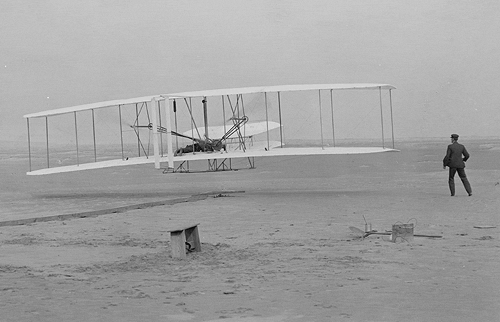Archive for May, 2011
Improve the US economy, one company at a time.
 I think we can turn around the US economy, one company at a time. Here’s how:
I think we can turn around the US economy, one company at a time. Here’s how:
To start, we must make a couple commitments to ourselves. 1. We will do what it takes to manufacture products in the US because it’s right for the country. 2. We will be more profitable because of it.
Next, we will set up a meeting with our engineering community, and we will tell them about the two commitments. (We will wear earplugs because the cheering will be overwhelming.) Then, we will throw down the gauntlet; we will tell them that, going forward, it’s no longer acceptable to design products as before, that going forward the mantra is: half the cost, half the parts, half the time. Then we will describe the plan.
On the next new product we will define cost, part count, and assembly time goals 50% less that the existing product; we will train the team on DFMA; we will tear apart the existing product and use the toolset; we will learn where the cost is (so we can design it out); we will learn where the parts are (so we can design them out); we will learn where the assembly time is (so we can design it out).
On the next new product we will front load the engineering work; we will spend the needed time to do the up-front thinking; we will analyze; we will examine; we will weigh options; we will understand our designs. This time we will not just talk about the right work, this time we will do it.
On the next new product we will use our design reviews to hold ourselves accountable to the 50% reductions, to the investment in DFMA tools, to the training plan, to the front-loaded engineering work, to our commitment to our profitability and our country.
On the next new product we will celebrate the success of improved product functionality, improved product robustness, a tighter, more predictable supply chain, increased sales, increased profits, and increased US manufacturing jobs.
On the next new product we will do what it takes to manufacture products in the US because it’s the right thing for the country, and we will be more profitable because of it.
If you’d like some help improving the US economy one company at a time, send me an email (mike@shipulski.com), and I’ll help you put a plan together.
a
p.s. I’m holding a half-day workshop on how to implement systematic cost savings through product design on June 13 in Providence RI as part of the International Forum on DFMA — here’s the link. I hope to see you there.
The carry-over task and fear of success
 The to-do list, whether digital or analog, we’ve all got ’em. We cross things off and put things on (mostly the latter); the list evolves – it’s a living thing.We put energy into adding things, tasks, action items. (You can’t go to a meeting without collecting one of them.)
The to-do list, whether digital or analog, we’ve all got ’em. We cross things off and put things on (mostly the latter); the list evolves – it’s a living thing.We put energy into adding things, tasks, action items. (You can’t go to a meeting without collecting one of them.)
But most telling to me are the tasks that stay on week-on-week, the carry-over tasks. We never do them, but we never take them off the list. What are they? Why don’t we do them? Why don’t we just take them off the list?
For tasks we complete, the fundamental motivating force is fear, fear of not getting them done, the consequences of failure. The deal is clear: we don’t complete the task, and something bad will happen to us. We know what will happen to us if we fail, we know the consequences of failure.
But the carry-over task is altogether a different beast. It’s an uncompleted task where the fundamental motivating force is still fear, but this time it’s the fear of getting them done, the consequences of success. The deal is absolutely unclear: we complete the task, and something good will happen to us. Though, this time we don’t know what will happen to us if we succeed, we don’t know the consequences of success.
With the carry-over task, we must supply our own motivation, our own energy, to overcome the consequences of something good happening to us us. Strange, but true.
With success comes visibility; with visibility comes judgement; with judgement comes fear, fear of being un-liked. We will be seen for what we are, and we’re afraid of what people will think. Some won’t like us, and that’s scary.
The fear of success is real, and it’s a tough nut. Some many not want to crack it, and that’s okay. For those that do, consider this: today, as you are, some don’t like you, so how could success be worse? With success, at least they’ll know why they don’t like you: because you succeeded.
For innovation, look inside.
 Everyone is dissatisfied with the pace of innovation – solutions that change the game don’t come fast enough. We look to the environment, and assign blame. We blame the tools, the process, the organization structure, and the technology itself. But the blame is misplaced. It is the innovators that govern the pace of innovation.
Everyone is dissatisfied with the pace of innovation – solutions that change the game don’t come fast enough. We look to the environment, and assign blame. We blame the tools, the process, the organization structure, and the technology itself. But the blame is misplaced. It is the innovators that govern the pace of innovation.
It certainly isn’t the technology – the solutions already exist; they’re patiently waiting for us, waiting for us to find them. We just have to look. The technology knows what it will be when it grows up: the path is clear. Put simply, we must break through our unwillingness to look. We must look harder, deeper, and more often. We must redefine our self-set limits, and look under the rocks of our successes and beyond our best work.
To increase the pace and quality of innovation, we must look inside.
a
a
p.s. I’m holding a half-day workshop on how to implement systematic cost savings through product design on June 13 in Providence RI as part of the International Forum on DFMA — here’s the link. I hope to see you there.

 Mike Shipulski
Mike Shipulski